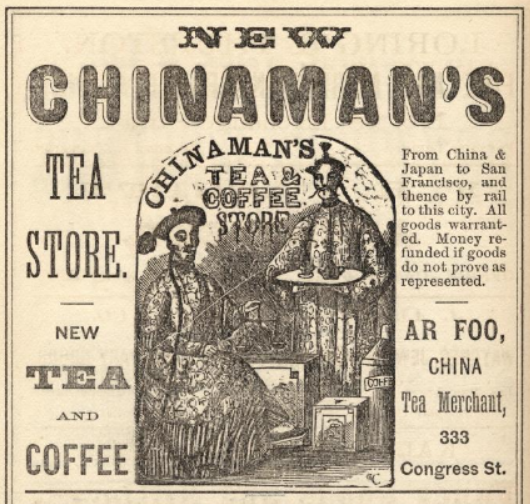By Kate Burch and Julie Ann Larry
In honor of Lunar New Year, we took a look back at the history of Portland’s Chinese community and created a map of significant sites of the Chinese community in Portland 100 years ago.
Chinese immigration to the US began in force during the mid-19th century, mostly in California and on the West Coast. One of the first documented Chinese immigrants in Portland was Ar Foo Fong, a tea merchant who came to Portland in 1860. He selected teas for George Shaw’s (founder of the Shaw’s supermarket chain) shop on Middle Street and later opened his own store on Congress Street. By the late 19th century, Portland had a small but vibrant Chinese community. The Portland newspapers reported on the celebration of the Moon Festival in 1884 and the Chinese New Year in 1895.
Chinese communities like the one in Portland remained small due in large part to racism and legal exclusion. The Chinese Exclusion Act of 1882 mostly banned the immigration of Chinese laborers to the US, prevented Chinese people from becoming US citizens, and made it almost impossible for the wives or families of Chinese laborers to join them. (There were some loopholes in the law, such as immigrating via Canada, that allowed a small number of Chinese people to come to the U.S. during exclusion.) Chinese immigration and naturalization remained restricted until the mid 20th century. Racist legislation also targeted Chinese-Americans with high taxes, banning Chinese customs, and preventing the Chinese from testifying in court.
In addition to institutional racism, Chinese-Americans also faced individual, often violent, persecution. Chinese people were run out of town, beaten, lynched, and massacred in cities and towns across the US during the 19th century. In Maine, many Chinese residents, were treated with derision and antagonism. Newspapers referred to them as “moon-eyed lepers” and “heathens”, and accused them of stealing jobs from Mainers. There are many documented assaults against Chinese-Americans and their businesses in the late 19th and early 20th centuries in Portland, with young men throwing rocks, breaking windows, stealing money from cash registers, and physically assaulting the Chinese residents.
Toy Len Goon managed her family’s laundry at 615 Forest Ave after her husband Dogun died in 1940. All of their 8 children went on to higher education, and in 1952 she was named Mother of the Year.
Language barriers and racial discrimination barred Chinese people from working in most industries during the late 19th and early 20th centuries, which caused many to open their own businesses – restaurants, shops, and laundries. Because running a laundry was a low-status job (considered “women’s work”) with low start-up costs and little English language skills required, it was particularly popular among new Chinese immigrants. Chinese laundries first appeared in Maine in the 1880s.
Like other immigrant communities, Chinese immigrants tended to live in close-knit communities. In Portland, many restaurant and laundry employees lived above the businesses where they worked, and several buildings were known as tenements for Chinese families and single men (there were many single men and relatively few women because the Chinese Exclusion Act prevented most Chinese women from immigrating, even to join their husbands.)
Empire Restaurant on Congress Street in 1933.
Maine’s Chinese population began to shrink around midcentury. Economic downturn in Portland and the closure of Chinese laundries due to mechanization caused many of Portland’s Chinese families to move to Boston, where there was a large Chinese community and better opportunities for employment.
Take a virtual walk through Portland’s Chinese community in the 1920s here!
We’re grateful for the research of Gary Libby and the resources provided by the Chinese-American Friendship Association of Maine and Maine Memory Network. For more information on the history of Maine’s Chinese community:
(PS: If you’re interested in the story of Chinese cuisine in America, check out the documentary The Search for General Tso!)



